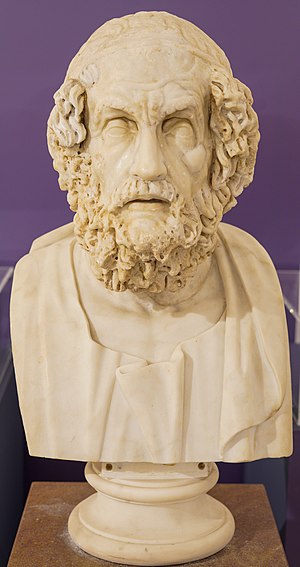Ancient Istroyan literature
Ancient ancient Istroyan literature is any literature written in the ancient Istroyan language from the earliest texts until about the 7th century AD when Caphiria conquered the islands.
Early literature

Ancient Istroyan literature begins with perhaps its greatest and most famous figure, Atrius, whose epic poetry is still published and studied today, though much is lost. Though Atrius' name has reverberated throughout history, the man himself remains shrouded in mystery to the point where his very existence is debated. Regardless, his trilogy of epics, The Aquiad, The Oneiro and the Nerosseus, set during a series of wars, are available in every major language and have been since the dawn of publishing. The works were originally part of a 15-cycle super-epic but these additional stories have been lost to history.
The Aquiad details the 12-day voyage of Lukantos, who is tempted away from his duties as a warrior on his way to fight by mermaids, demons and a nightmare in which his own wife attempts to call him back to his home. He remains true to his purpose and lands at his destination, with the story ending before his actual battle is described; it is assumed this is covered in another poem. The Oneiro chronicles Onodotus, an army general who leads his men in a siege of the fictional city of Thavmastos; there is a relatively modern conspiracy theory that Thavmastos was a real place which has since been destroyed. Atrius' final surviving work is the Nerosseus, in which the gods themselves ask Iroas to murder the king of the enemy by disguising himself as one of their soldiers.
Poetry
Epic poetry
Aside from the poetry of Atrius, epic cycles were also penned by Hekiod and Kiruscus, who unlike Atrius refer to themselves in their poetry and tell of ordinary men rather than soldiers. The Istroyan gods feature heavily in all of these epic poems, meddling in mortal affairs and offering judgements on the main characters. Epic poetry was written in hexameter.
Lyric poetry
Lyric poetry was intended to be sung and was considered a lesser artform than epic poetry but still garnered respect. Also unlike epic poetry, lyric poetry was known to be written by women, and employed a variety of different meters unlike the stricter epics.
Later lyric poetry detailing the arrival of Caphirian invaders as the Istroyan civilisation fell around them is considered particularly important by today's historians.
Drama
Drama was enjoyed by the people of Istroya, being performed in open-air theatres for the public. The classification of dramas has its roots with the ancient Istroyans, who kept comedies, tragedies and satires apart from one another. There are 19 surviving plays attributed to Koripides, the most famous of which is surely Mina, regarding a woman (the titular Mina) who leaves her husband, Dimoyicus for another man, leading Dimoyicus to murder him and then himself, leaving Mina with no one.
Histories and biographies
Istroyan writer Tikos is known as "the father of history" as his work, simply titled The Histories of Tikos, is among the earliest western examples of a written history. His son Torallon carried on his work with a book titled The Acts of The Imperators, from which much of our knowledge of early Istroyan leaders comes. Torallon also made the first known record of the ancient Istroyan Games.
Polygrius wrote a record of several other cultures the Istroyans came into contact with, generally characterising those from Sarpedon as warlike, untrustworthy and cunning and those from Audonia as slow, lazy and uncultured. He also wrote a collection of common, day-to-day anecdotes which were unappreciated in his time but vindicated by historians who saw that such records were rare compared to the records of high-society.
Science and mathematics
Euchimedes and Archlid are famous for their contributions to mathematics and science, with Kobrakus known to contribute to both, as well as philosophy and the first known western treatise on music theory. Archlid was the founder of modern geometry; calculating a surprisingly accurate value of pi and calculating the circumference of the globe.
Anemen wrote detailed anatomical studies of the human skeleton and made early geographical sketches of the Melian Islands. He also penned an early kind of travel guide simply known as Description of Istroya.
Philosophy
Istroyan thinkers' influence on philosophy cannot be overstated; Kobrakus, Quilgo and Netetle are all considered among the most important minds in history, having made marks on philosophy, mathematics and all branches of science. Quilgo's works on the nature of love, the ideal government, the composition of matter and the laws of the animal kingdom were unlike anything published to that point, and it is thought he had much more to say, but unfortunately he wrote none of his ideas down, and is only known through the recordings of his student Netetle, who also contributed his own ideas relating to morals, ethics, aesthetics and the possibility of the physical presence of a soul inside the body. Pharides of Zukharno of the Melian Isles was also famous for his works on human nature and warfare.
Prose
Little prose fiction survives from Istroya, however an anonymous work now simply titled An Istroyan Tale due to the loss of the original title has been recovered, detailing a basic love story and a battle with a gigantic serpent.
Legacy
Ancient Istroyan writings were tremendously influential on western literature as a whole, and eventually made their way around the entire world, inspiring early Audonian astronomers and Levantine poets. While largely forgotten during the middle ages, literature once again began to take influence from Istroya going into the modern period, with most schools from Crona to Alshar covering Istroyan texts in some capacity.